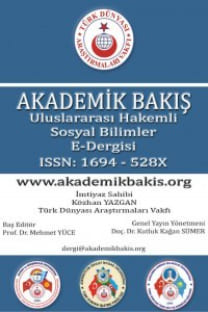KURT MOTİFİ ÜZERİNE BİR İNCELEME
Kurt, Türk milletinin sembolüdür. Ortaasyadan bu yana, özellikle Oğuz Destanında ve diğer destanlarımızda kurt, yol gösterici olarak dikkat çeker. İnsanın başka bir canlıya dönüşmesi ( Don değiştirme- methamorphose ) ise sadece bizde değil, dünya masallarında da var olan bir durumdur. Edebiyatımızda özellikle Millî Mücadele dönemi edebî ürünlerinde kurt motifi dikkate değer bir özellik taşımaktadır. Alfred de Vignynin Kurdun Ölümü şiirinin en güzel açıklaması Yahya Kemal tarafından yapılmış, Türk milletinin verdiği büyük mücadeleyle kurdun verdiği ölüm kalım mücadelesi arasında bir benzerlik kurulmuştur. Halide Edip, yurt dışında izlediği kurt motifli bir filmden çok etkilenmiş ve o da Dağa Çıkan Kurt adlı hikâye kitabını meydana getirirken yine Türk milletinin içinde bulunduğu ölüm kalım savaşını göz önüne almıştır. Ancak günümüzde de popüler kültürde, özellikle bazı filmlerde malzeme olarak kurt motifinin dikkat çektiği görülmektedir. Fakat bilinmelidir ki, kurt motifi ve kurda dönüşme, içinde kurt motiflerinin olduğu ürünler, Ortaasya Türk kültüründen tüm dünyaya yayılmıştır. Makale bu motifin izlerini sürecek, Türk mitolojisinde ve edebiyatında görünümünü ele alacak ve günümüzde bu malzemenin popüler kültürün malzemesi olarak nasıl işlendiğini belirlemeye çalışacaktır.
Anahtar Kelimeler:
Kurt, motif, edebiyat, popüler toplum
A RESEARCH ON KURT MOTİVE
Wolves are the symbol of the Turkish Nation. The wolves stand out as the guiding spirit since the period of Central Asian Turks, especially in the Oğuz Epic and the other epics. Metamorphose of human beings is not a situation existing for us only, but for all the human beings. In our literature, the wolf pattern has an incredible feature in the literary works of the period of National Struggle. Yahya Kemal explained Death of a Wolf, a poem by Alfred de Vigny, best and made an analogy between the great struggle the Turkish people were experiencing and the struggle the wolf was making while dying. Halide Edip was impressed a lot by a film with a wolf pattern and while she was writing her story book called The Wolf that Took the Hills, she took the death- or -life struggle of the Turkish nation as example. However, we can see that the wolf pattern is being used especially in some films in the popular culture. We should know that the wolf pattern or turning into a wolf, the products with wolf patterns have all spread to the world from Central Asian Turks. Our study will follow the traces of this pattern, will deal with the presence of it in Turkish mythology and literature and will try to identify how this is used as the material of the popular culture.
Keywords:
Wolf, pattern, literature, popular society,
- Başlangıç: 2004
- Yayıncı: Akademik Bakış
Sayıdaki Diğer Makaleler
TÜRKİYE’DEKİ DİZİ İZLEYİCİLERİNİN KULLANIMLAR DOYUMLAR YAKLAŞIMIYLA İNCELENMESİ
Mehmet Özer DEMİR, Zuhal Gök DEMİR
19. Y.Y.DAN CUMHURİYETE OSMANLI İMPARATORLUĞUNDAN DEVRALINAN GİRİŞİMCİLİK MİRASI
İBN SİNA İLE KİERKEGAARDIN ÖLÜM ANLAYIŞININ KARŞILAŞTIRMASI
ÜNİVERSİTELİ ÖĞRENCİLERDE DİNDARLIĞI ETKİLEYEN BAZI FAKTÖRLER
KURT MOTİFİ ÜZERİNE BİR İNCELEME
TÜRKİYE TÜRKÇESİNDEKİ TÜREMİŞ KÖK FİİLLERİN YAPI VE ANLAM ÖZELLİKLERİ
Şirvan Şen DEMİR, Betül YEŞİLTEPE, Mahmut DEMİR
